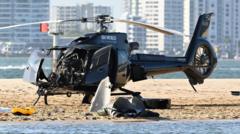The mid-air disaster took place in January 2023, resulting in several serious injuries and sparking widespread concerns about aviation safety. According to the Australian Transport Safety Bureau (ATSB), the crash, which involved two helicopters, was precipitated by a vital radio call that the pilot of one helicopter did not hear due to faulty equipment.
The incident occurred approximately 20 seconds after one helicopter took off as another was attempting to land. The aircraft preparing for takeoff had a faulty antenna, which resulted in the pilot being unaware of an incoming helicopter's landing status. While loading passengers, ground crew assured the departing pilot that the airspace was clear, but this information was outdated by the time the helicopter took off.
In the lead-up to the collision, Sea World had made several operational changes aimed at enhancing its leisure flights, which inadvertently weakened existing risk management measures. The ATSB's report critiques these modifications for creating a dangerous traffic separation conflict between landing and departing aircrafts.
Among the fatalities were Diane Hughes, 57, and her husband Ron, 65, celebrating their recent marriage. The other victims included Sydney local Vanessa Tadros, 36, and Sea World Helicopters pilot Ashley Jenkinson, aged 40. Following the incident, passengers from the other helicopter praised the pilot for managing an emergency landing that averted further disaster.
The ATSB has made 28 safety findings from the investigation, highlighting vital lessons regarding the management of changes in aviation operations. Chief Commissioner Angus Mitchell emphasized the necessity for structured processes to ensure safety is not compromised when improvements are implemented.
The incident has raised significant alarm regarding the protocols in place at one of Australia’s most popular tourist destinations, as communities mourn the loss of lives cut short in a senseless accident.
The incident occurred approximately 20 seconds after one helicopter took off as another was attempting to land. The aircraft preparing for takeoff had a faulty antenna, which resulted in the pilot being unaware of an incoming helicopter's landing status. While loading passengers, ground crew assured the departing pilot that the airspace was clear, but this information was outdated by the time the helicopter took off.
In the lead-up to the collision, Sea World had made several operational changes aimed at enhancing its leisure flights, which inadvertently weakened existing risk management measures. The ATSB's report critiques these modifications for creating a dangerous traffic separation conflict between landing and departing aircrafts.
Among the fatalities were Diane Hughes, 57, and her husband Ron, 65, celebrating their recent marriage. The other victims included Sydney local Vanessa Tadros, 36, and Sea World Helicopters pilot Ashley Jenkinson, aged 40. Following the incident, passengers from the other helicopter praised the pilot for managing an emergency landing that averted further disaster.
The ATSB has made 28 safety findings from the investigation, highlighting vital lessons regarding the management of changes in aviation operations. Chief Commissioner Angus Mitchell emphasized the necessity for structured processes to ensure safety is not compromised when improvements are implemented.
The incident has raised significant alarm regarding the protocols in place at one of Australia’s most popular tourist destinations, as communities mourn the loss of lives cut short in a senseless accident.

















